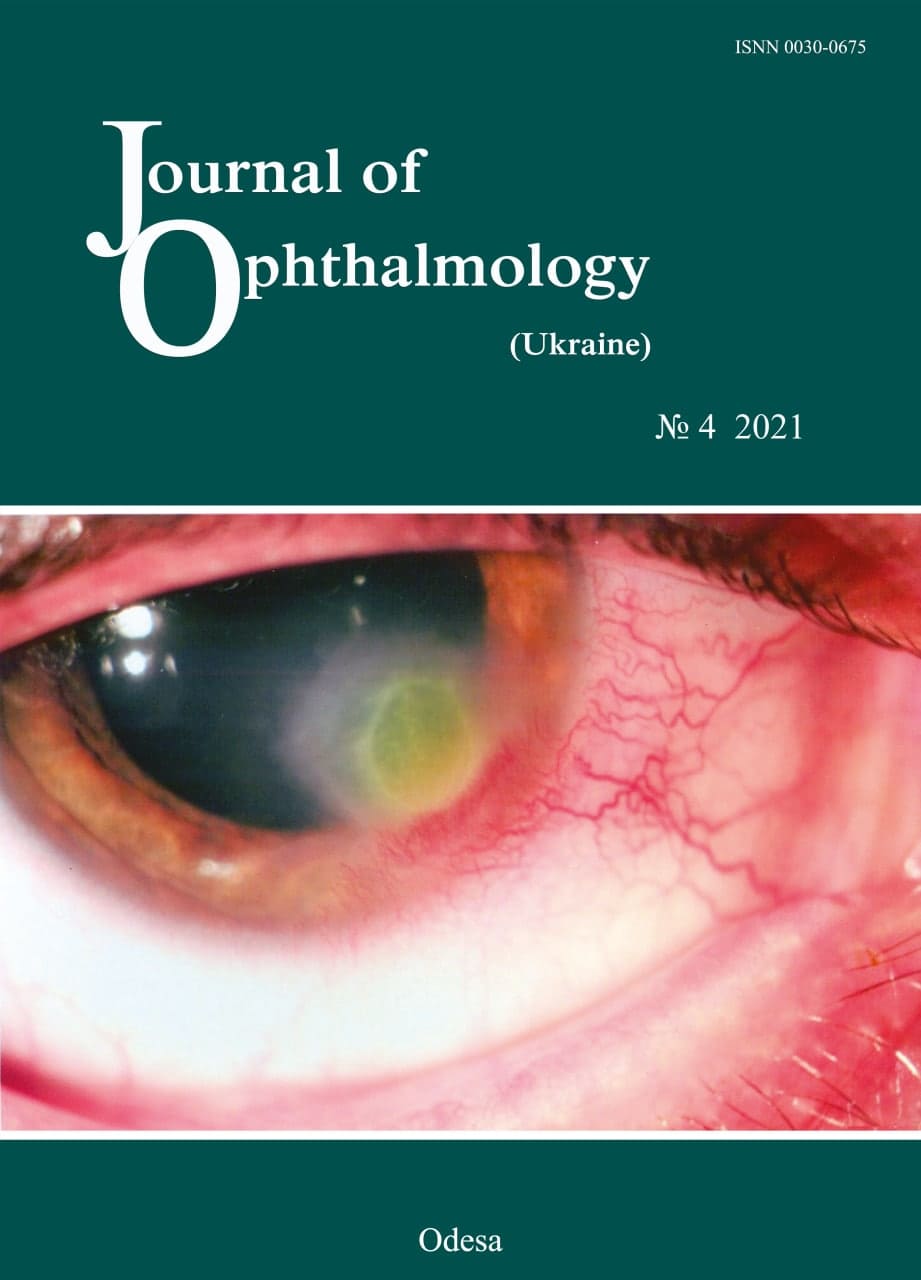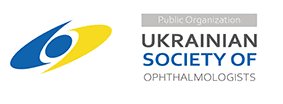Results of a study on the stress-strain behavior of the cornea in polarized light under conditions of visual work
DOI:
https://doi.org/10.31288/oftalmolzh202146166Keywords:
extraocular muscles, polarized light, stress-strain behavior of the cornea, interference patterns, symmetry coefficientAbstract
Background: Near visual work causes redistribution of internal stresses in the cornea, leading to a change in the shape and parameters of the interference patterns observed on the cornea in polarized light.
Purpose: To assess the effect of various types of visual load on the extraocular muscles (EOM) in children and adolescents on the basis of characteristics of the interference patterns observed on the cornea in polarized light.
Material and Methods: The interference patterns observed on the cornea in polarized light were studied in children and adolescents before and after they performed a visual load task which consisted in either working with texts printed on paper at different parameters of convenience for reading (97 individuals) or playing Tetris on a smartphone (58 adolescents). A symmetry coefficient K was calculated for the quantitative assessment of changes in interference pattern parameters induced by visual load.
Results: Performing a visual load task which consisted in working with texts printed on paper resulted in a significant increase in asymmetry between the actions of the EOM in 60% to 73% of children; this was indicated by the values of a symmetry coefficient K which were twofold to six-fold higher than normal. Performing a visual load task which consisted in playing Tetris on a smartphone resulted in an increase in asymmetry between the actions of the EOM in 64% of adolescents.
Conclusion: Our research confirmed that studies on the stress-strain behavior of the cornea in polarized light are promising for assessing the effect of various types of visual load on the function of EOM.
References
1.Brewster D. Experiments on the depolarization of light as exhibited by various mineral, animal and vegetable bodies with a reference of the phenomena to the general principles of polarization. Phil Trans Roy Soc. Lond. 1815; 1: 21-53.
2.Anderson K., El-Sheikh A., Newson T. Application of structural analysis to the mechanical behavior of the cornea. J R Soc Inter-face. 2004 Nov 22;1(1):3-15. https://doi.org/10.1098/rsif.2004.0002
3.Bour LJ, Lopez Cardozo NJ. On the birefringence of the living human eye. Vision Res. 1981;21(9):1413-21. https://doi.org/10.1016/0042-6989(81)90248-0
4.Cogan DC. Some ocular phenomena produced with polarized light. Arch Ophthalmol. 1941;25(3):391-400.https://doi.org/10.1001/archopht.1941.00870090013001
5.Stanworth A, Naylor EJ. Polarized light studies of the cornea I. The isolated cornea. J Exp Biol. 1953; 30:160-3.https://doi.org/10.1242/jeb.30.2.160
6.Stanworth A. Polarized light studies of the cornea II. The effect of intraocular pressure. J Exp Biol. 1953;30(2):164-9.https://doi.org/10.1242/jeb.30.2.164
7.Stanworth A, Naylor EJ. The polarization optics of the isolated cornea Br J Ophthalmol. 1950; 34(4):201-11.https://doi.org/10.1136/bjo.34.4.201
8.Zandman F. The photoelastic effect of the living eye. Experim Mechanics. 1966;6(5):19A-22A.https://doi.org/10.1007/BF02327314
9.Vodovozov AM, Kovylin VV. [Isoclinals of the interference picture of the cornea as indices of the position of the extraocular mus-cles in healthy subjects and in strabismus]. Oftalmol Zh. 1983;38(5):260-2. Russian.
10.Kovtun NM. [Interference Patterns of the Eye Cornea with Different States of Oculomotor Muscles]. Ukrainskyi zhurnal medytsyny, biologii ta sportu. 2017; 2(6): 81-6. https://doi.org/10.26693/jmbs02.06.081
11.Kochina ML, Demin YuA, Kovtun NM. [Peculiarities of Interferential Pictures of Eyes at Horizontal Heterotropy]. Ukrainskyi zhurnal medytsyny, biologii ta sportu. 2017; 2(4): 96-103. Russian. https://doi.org/10.26693/jmbs02.02.075
12.Kochina ML, Demin YuA, Kovtun NM, Kaplin IV. [Results of polarized light use for study of stress−strain state of cornea in pa-thology of extraocular muscles]. Mizhnarodnyi meduchnyi zhurnal. 2019; 25,3(99): 65-9. https://doi.org/10.37436/2308-5274-2019-3-12
13.Kochina ML, Kaplin IV, Kovtun NM. [The Results of Polarized Light Usage for the Eye Research]. Visnyk problem biologii i medytsyny. 2014; 4(113):139-45. Russian.
14.Penkov MA, Kochina ML. [Interferential method of diagnosing strabismus]. Oftalmol Zh. 1979;34(8):497-8. Russian.
15.Penkov MA, Kochina ML. [Method for diagnosing pathologic intraocular pressure]. Oftalmol Zh. 1981;36(8):476-9. Russian.
16.[A method of measuring intraocular pressure]: US Pat. 33640 Ukraine: IPC (2006), 3/16, А61В 8/10. Declared 23.10.2007; pub-lished 10.07.2008. URL: http://uapatents.com/2-33640-sposib-vimiru-vnutrishnoochnogo-tisku.html.
17.Kaplin IV, Kochina ML, Firsov OG. [The Conception of Telemedicine System for Express Estimation of Intraocular Pressure's Level]. Kibernetika i vychislitelnaia tekhnika. 2018; 1(191): 76-94. https://doi.org/10.15407/kvt191.01.076
18.Kaplin IV, Kochina ML, Demin IuA, Firsov AG. [The system of intraocular pressure assessment using interference eye pictures]. Kibernetika i vychislitelnaia tekhnika. 2019; 1(195): 64-81. Russian.https://doi.org/10.15407/kvt195.01.064
19.Kochina ML, Yavorsky AV, Evtushenko AS. [The role of visual load in process of children and teenagers visual system's for-mation]. J Ophthalmol (Ukraine). 2015; 4: 3-10. Russian. https://doi.org/10.31288/oftalmolzh20154310
20.Kochina ML, Yavorsky AV, Maslova NM. [Peculiarities of impact produced by different visual load of functioning of visual sys-tem in children and adolescents]. Aktualni problem suchasnoi medytsyny. 2017; 1(57):12:112-6. Russian.
21.Evtushenko AS, Kozak LM, Kochina ML, Yavorsky AV. [Results of human functional state's assessment during the visual work]. Svit medytsyny ta biologii. 2015;2(50):39-44. Russian.
22.[Declaratory patent for the invention Ukraine, 43719 A UA, IPC A 61 B 10/00]. [A method for diagnosing the information load of printed publications for children and adolescents]; declared 06.06.01; published 17.12.01; Bul. № 11. Ukrainian.
23.Kochina ML, Demin YuA, Yavorsky AV, Kovtun NM, Firsov OG. Clinical decision support system for extraocular muscle pa-thology. J Ophthalmol (Ukraine). 2020;2(493):70. https://doi.org/10.31288/oftalmolzh202027078
24.Sergeta IV, Podrigalo LV, Malachkova NV. [Ophthalmic and hygienic aspects of current visual environment in children, adoles-cents and young adults]. Vinnytsia: Dilo; 2009. Russian.
25.Kovtun NM. [Scientific substantiation and development of a method for assessing the condition of oculomotor muscles using polar-ized light]. [Abstract of a thesis for the degree of Cand Sc (Med)]. Kyiv: The Shupyk National Medical Academy of Postgradu-ate Education of the Ministry of Public Health of Ukraine; 2021. Ukrainian.
Downloads
Published
How to Cite
Issue
Section
License
Copyright (c) 2025 М. Л. Кочина , И. В. Каплин , Н. М. Ковтун , Н. М. Маслова , А. В. Яворский

This work is licensed under a Creative Commons Attribution 4.0 International License.
This work is licensed under a Creative Commons Attribution 4.0 International (CC BY 4.0) that allows users to read, download, copy, distribute, print, search, or link to the full texts of the articles, or use them for any other lawful purpose, without asking prior permission from the publisher or the author as long as they cite the source.
COPYRIGHT NOTICE
Authors who publish in this journal agree to the following terms:
- Authors hold copyright immediately after publication of their works and retain publishing rights without any restrictions.
- The copyright commencement date complies the publication date of the issue, where the article is included in.
DEPOSIT POLICY
- Authors are permitted and encouraged to post their work online (e.g., in institutional repositories or on their website) during the editorial process, as it can lead to productive exchanges, as well as earlier and greater citation of published work.
- Authors are able to enter into separate, additional contractual arrangements for the non-exclusive distribution of the journal's published version of the work with an acknowledgement of its initial publication in this journal.
- Post-print (post-refereeing manuscript version) and publisher's PDF-version self-archiving is allowed.
- Archiving the pre-print (pre-refereeing manuscript version) not allowed.












